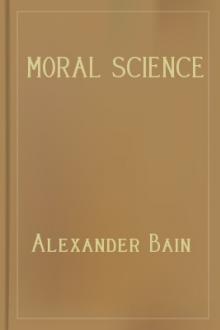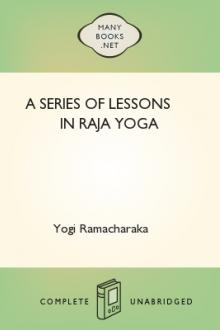Man's Fate and God's Choice, Bhimeswara Challa [best free ereader .TXT] 📗

- Author: Bhimeswara Challa
Book online «Man's Fate and God's Choice, Bhimeswara Challa [best free ereader .TXT] 📗». Author Bhimeswara Challa
The Vedas proclaim that ‘separation is death; union with self is life’; and that “Ekatma sarvabhoota antaratma” (the one Atman is present in all beings). “Tarati sokam atmavith” (the knower of the Self overcomes sorrow), say the Upanishads. It is important to note the distinction between the ‘self’ as relating to one’s own self and the Vedantic ‘Self’. The Western concept of self-knowledge is symbolized by the ancient Greek aphorism inscribed in the pronaos (forecourt) of the Temple of Apollo at Delphi: know thyself, which primarily is a search for truth, an intellectual process of knowing the meaning of man and of life. The Self-knowledge as described in the Vedas and Upanishads is a much broader theological concept and covers the relationship between man, self, and God. It is to intuitively know or rather ‘realize’ that there is no difference between the jivatman (the individual self), and the paramatman (the universal Self). The Mundaka Upanishad gives a sharp description of the individual self and the universal Self using the analogy of two birds of golden plumage perched on top of the same tree, which is the body (and by extension the universe), the former tasting the sweet and bitter fruits of the tree and the later calmly observing. The individual self, deluded by forgetfulness of his identity with the divine Self, bewildered by his ego, grieves and is sad. But when he recognizes the Supreme as his own true Self, and beholds His glory, he grieves no more. The implication is that we feel as if we are drowned, submerged, in the deadly ocean of samsara, in the continuum of birth, death, pain, and confusion. Adi Shankara points out that the individual is overwhelmed with confusion because it cannot understand what is really happening to it, and why. Just like a piece of driftwood on the swirling sea, the individual is lifted up and down, thrown onto the shore and then pulled back into the sea. Experiencing within its own being the presence of
God — and thereby realizing that glory as his own — the individual becomes liberated from suffering and sorrow. Such knowledge erases the sense of separateness. It is consciousness that is the key to personal identity. We are the same person only to the extent that we are conscious of our past thoughts and actions, in the same way as we are conscious of our present thoughts and actions.
At a practical level, we have not discovered a moral modus vivendi to reconcile and harmonize life on three planes: (1) the complex of ‘needs, wants and desires’ that characterize the ‘I’ of one person with those of another ‘I’ of another person; (2) the reality that the birth, travails and death of one person are organically related to those of another person; and (3) the autonomy of human behavior with the cosmic maxim that the tiniest act, maybe even a stray thought, of every person has a collective ripple effect on human evolution. What binds us, above all, is ignorance centered somewhere about which we are utterly ignorant. Everything in Nature seems to limit us, like the law of gravity, like the organic nature of our being, and the wheel of birth, life and death, what is called the samsara- chakra in Sanskrit. Mired in ignorance about our true essence and subjected to forces over which we have absolutely no control, we meander meaninglessly in the pursuit of the phantoms of pleasure, profit, and power. We are pitch-forked into what we call life, or somnambulism as Thomas Carlyle called it, without our permission or previous experience, and we die without knowing about what is going to come next. We are all aware that death, defined as irreversible damage to the chemistry of life, like reproduction and metabolism, is an essential feature of life. The subconscious in man has not only an instinct for life but also an abhorrence of death, and for reasons we do not know, the dread of death is weakening in the face of the rigors of modern living and a heartless society. Battered and bruised, deprived of any hope of a future of their own making, death has come to be for many the ‘only victory in life’. Vedanta, in a flash of intuitive brilliance, says that the way forward is the way within, that in knowing oneself, one gets to know who the ‘others’ are; and in knowing who or what we are not, we will also know the oneness of all. The ‘I’-thought is the first to arise in the mind, and if this question is tirelessly pursued, all other thoughts will be extinguished, and finally the I-thought itself will meet the same fate, opening the door to self-dissolution and awakening of the non-dual Self. In the Upanishads, the essence of identity is approached through what we might call a ‘sculptor’s chisel’: just as a sculpture emerges as one chips away at a stone, so does our true essence get revealed by eliminating what it is not: “I am not the five senses”; “I am not the sense-organs”; “I am not the gross body”; “I am not the mind”
… “I am ‘neti, neti’ (not this, not this)”. By exhausting everything, one is left with Nothing or Everything, the all-pervasive but visually invisible Brahman, the existence — consciousness
— bliss, as Indian lore has it. In the sense in which Ramana Maharshi expounded his philosophy, it is a step forward in the Advaita philosophic thought of non-dualism — it is no longer a question of the union or unity of the I-persona and God: there is no ‘I’ at all; everything and everyone, from the spider to snake to ape to man, they are all wholly and nothing but God; pure God. In other words, it is a giant leap beyond the Upanishadic maxim ‘Aham brahmasmi’ (I am Brahman or God). If there is no ‘I’, there can only be God. For man, more so for the modern man, to reach that certain shore of genuine experience of self- knowledge, which can reveal to him the true meaning of his existence, has been an uphill, almost impossible task. Thwarted in his thirst, mired in desolate despair, expectation turning into exasperation, liberation is dangling before man as a release from the burden of the body, to escape from the tedium of life. Man’s agony comes from realizing that our carnal flesh refuses to respond to the requirements of divine dictum or the Law of Nature. Those things which we often despise, we find ourselves doing. Those things which we desire, we fail to do. As Paul describes his frustration in the Bible, with his mind he desires to serve God. He agrees with the Law of God and rejoices in it. He wants to do what is right, but his body will
not respond. He watches, almost as a third party, as sin sends a signal to his body and as his body responds, he wails: “Wretched man that I am! Who will set me free from the body of this death?” (Romans 7:24). To borrow the words from a Michael Jackson lyric, for many who see a rainbow all in black and feel a bad taste in the mouth through bitter tears, merging with God has come to mean all-round annihilation.
Man — a mixed blessing
From the first breath of the new born to the last breath before death, everything we do is grounded in the belief that we are the finest, the best, and the brightest on earth. While we are too close to action and too subjective as central characters in the terrestrial play, it is fair to presume that the presence or existence of the human ‘habitation’ on earth has been a mixed blessing. We never consider ourselves as ‘co-habitants’, but as the sole-habitants of the earth, if not the sovereign ones. In objective terms and in the context of what we are equipped with by Nature, we have never been able to fulfill our premise or measure up to our full potential. It was not widely off the mark when the American music band Death said, in the lyrics of their composition In Human Form (1993), that [the human form is] “an atrocity laced with greed; filled with evil intentions, ready to attack; dark emotions run through its veins; this creature in human form is out of control”. But that dismal ‘vision’ is based on behavior.
Whatever was our origin, however we are made, and whatever brought us to the present pass, it is open to question if the earth would not have been better off had man never materialized. The scriptures, on the other hand, view the human form as a vehicle to transport the inhabitant to the realm of the divine. Science says a human being is the finest form there is — or could be — on this planet. The scriptures and science might be united in extolling the human as the pinnacle of the pyramid of life on earth, but there are vital differences in their views of life. While our ancient wisdom preaches the oneness of all life, moral conduct, spiritual growth, and God’s grace as necessary in life, science says that the goal of human life is to sip the cup of life to the last drop, bolster the body, boost brainpower, yet remain human and be alive perpetually. According to science, there is nothing much left for man beyond the basics, biology, survival and reproduction, and eventually, as Bertrand Russell puts it, all the genius of Man and his achievements since his advent on earth are doomed to be buried beneath the debris of a universe in ruins. But that has not yet happened, nor has it deterred science from trying to make man, more precisely the body, immortal and impregnable. It is this epic battle that man is waging now. The human body is remarkably well designed, exquisitely engineered. In the words of the Italian Renaissance philosopher Pico della Mirandola, there is nothing to be seen more wonderful than the image of man.
Michelangelo’s ‘David’ and Leonardo da Vinci’s ‘Mona Lisa’ reflect this image. But it is not the last word; and it is a perplexing paradox. The human is at once versatile and vulnerable; formidable and fragile, highly adaptive but liable to collapse anytime and become an easy prey. There is a Turkish proverb that says, “Man is harder than iron, stronger than stone, and more fragile than a rose”. Most of our organs have a great deal of extra capacity or reserve: They can still function adequately even when damaged. But every single part or process, from the skin to the heart to the digestive system and the nervous system, is prone to disease or crippling disorder.
Despite great advances in epidemiology, we still do not know — or know very little
— of the relation between what we eat, drink, and breathe, and where we live, on the one hand, and our susceptibility to a certain disease, on the other hand; and why, in an identical environment, different people are differently susceptible. The human organism is not impervious or immune





Comments (0)